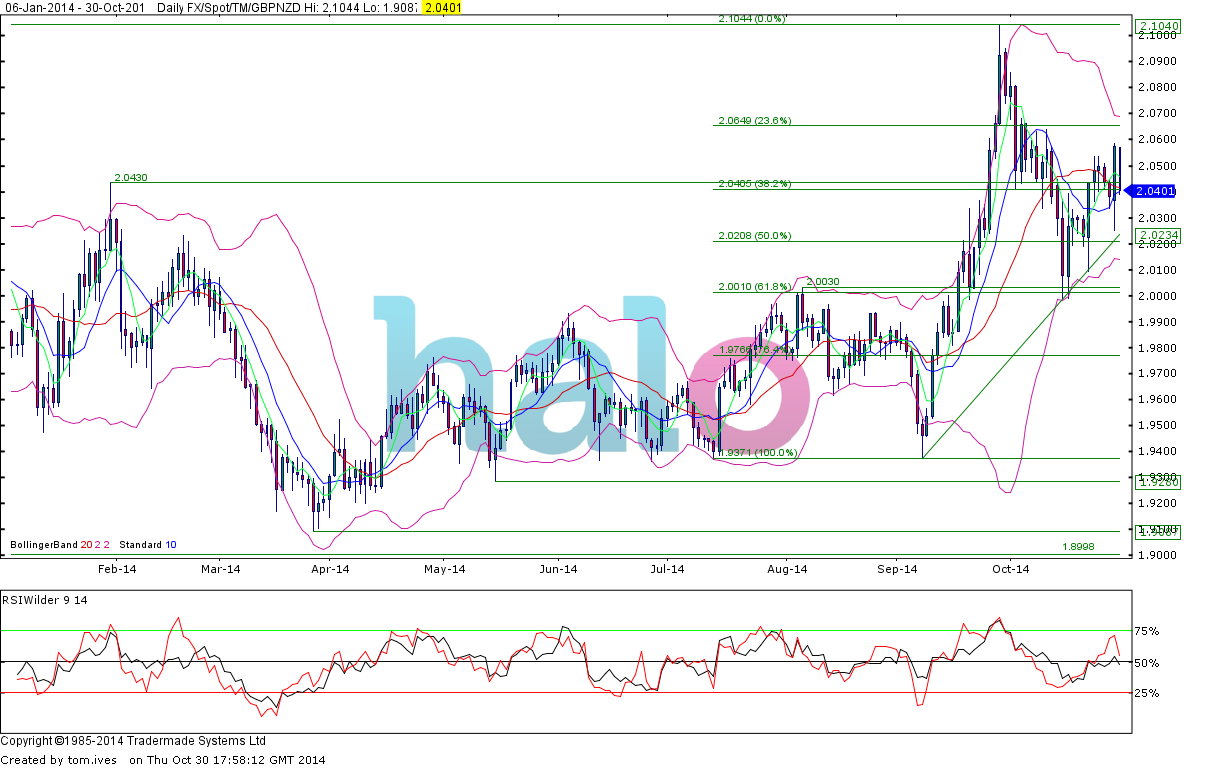New Zealand Dollar Research Report
RBNZ leave rates on hold
Governor Wheeler says that the NZ dollar is still too high
Sterling New Zealand Dollar (GBPNZD) FX Technical Analysis
Having tested the 3 year high of 2.104 on the 29th of September, GBP/NZD has corrected and appears to have entered a consolidation phase for the time being.
Apart from being technically oversold, we have seen the rates come under pressure due to a combination of data releases. Interest rates in the UK look to be on hold for longer than expected, due to weak consumer activity (retail sales slipped once again in September) and UK Consumer Price Index (CPI) inflation falling to a 5 year low.
With the consumer feeling the squeeze and inflation remaining low, the Bank of England have signalled they’re happy to leave interest rates on hold in the face of a slowing global economy.
The story is similar in New Zealand where inflation has fallen to the lower end of the Reserve Bank of NZ’s (RBNZ) inflation target (1-3%). The RBNZ had a rate announcement yesterday evening, at which Governor Wheeler suggested that interest rates would remain on hold for an extended period due to falling inflation and the persistent strength of the Dollar. He suggested that the Kiwi remained unjustifiably and unsustainably high, which is strikingly similar language to when the RBNZ intervened in the markets earlier this year.
Technically, we have seen the market complete a 61.8% correction of the move from 1.9371 to 2.1044 over the course of the month as remain within an uptrend. However. We need to see support in the 2.0234 region (current trend line support) hold for this to remain the case. Otherwise, we appear to be settling into a consolidation phase as we have seen on numerous occasions over the last 3 years. Thankfully, there seems to be solid support in the 2.00 region (Fibonacci support, recent low and psycholigical) which should underpin the market. A break of this level would be a concern and should be something that is monitored. On the top side, 2.1044 is a long term level of resistance that has been tested on 3 occasions over the last 3 years and needs to be respected for the time being.
For NZD Buyers
It is really a question of timeframes, if you’re looking at making a transfer in the coming months then I would suggest the placement of a limit order in 2.08-2.09 region as this has been a long term level of resistance. However, anything above 2.00 has represented a decent level to purchase kiwi over the last 3 years. So it is really down to your appetite for risk as to the level you target. As mentioned above, there is solid support in the 2.00 region a break of which would be a real concern. I would consider the placement of a stop loss order in the 1.98 region just in case as it would be a real shame to see the market move below this level once more.
For NZD Sellers
The good news is that 2.1044 held, as long as this is the case then you stand a chance of being able to achieve better levels. In the short term, I would be tempted to trade a portion on a test of the current uptrend, with the balance to be traded should we see a test of 2.00. Whilst these rates are slightly disappointing for sellers given the rates of the last few years, it should not be forgotten that rates in this region are the exception as opposed to the norm over the long term.
Trading foreign exchange on margin carries a high level of risk, and may not be suitable for all investors. The high degree of leverage can work against you as well as for you. Before deciding to invest in foreign exchange you should carefully consider your investment objectives, level of experience, and risk appetite. The possibility exists that you could sustain a loss of some or all of your initial investment and therefore you should not invest money that you cannot afford to lose. You should be aware of all the risks associated with foreign exchange trading, and seek advice from an independent financial advisor if you have any doubts.
Recommended Content
Editors’ Picks
EUR/USD climbs to 10-day highs above 1.0700

EUR/USD gained traction and rose to its highest level in over a week above 1.0700 in the American session on Tuesday. The renewed US Dollar weakness following the disappointing PMI data helps the pair stretch higher.
GBP/USD extends recovery beyond 1.2400 on broad USD weakness

GBP/USD gathered bullish momentum and extended its daily rebound toward 1.2450 in the second half of the day. The US Dollar came under heavy selling pressure after weaker-than-forecast PMI data and fueled the pair's rally.
Gold rebounds to $2,320 as US yields turn south

Gold reversed its direction and rose to the $2,320 area, erasing a large portion of its daily losses in the process. The benchmark 10-year US Treasury bond yield stays in the red below 4.6% following the weak US PMI data and supports XAU/USD.
Here’s why Ondo price hit new ATH amid bearish market outlook Premium

Ondo price shows no signs of slowing down after setting up an all-time high (ATH) at $1.05 on March 31. This development is likely to be followed by a correction and ATH but not necessarily in that order.
Germany’s economic come back

Germany is the sick man of Europe no more. Thanks to its service sector, it now appears that it will exit recession, and the economic future could be bright. The PMI data for April surprised on the upside for Germany, led by the service sector.
